
A blenny fish is a small, bottom-dwelling, perciform marine fish found in the Atlantic and Pacific oceans. They are typically characterized by their elongated bodies and long dorsal fins with short spines. Blennies have large heads with prominent eyes and often colorful markings, making them popular aquarium inhabitants.
Depending on their habitat, they can adapt to different lifestyles. Some remain in coral reefs, while others become territorial residents of rocky shores or tide pools. Blenny fishes feed on algae, planktonic crustaceans, mollusks, and other invertebrates in shallow water environments where they hide for protection from larger predators.
12 Types of Blenny Fish
Blenny fish come in a wide variety of shapes, sizes, and colors. From the diminutive Finescale Blenny to the large Meiacanthus Grammistes, these fish offer something for every aquarium enthusiast. With bright orange stripes or subtle earth tones, blennies can make an eye-catching addition to any tank.
Many species are also quite hardy and peaceful, making them perfect for novice aquarists and reef tanks alike! Whether you’re looking for a shy bottom dweller or a more outgoing mid-water swimmer, there is sure to be at least one type of Blenny that will fit your needs perfectly.
Here are our favorites!
Tailspot Blenny
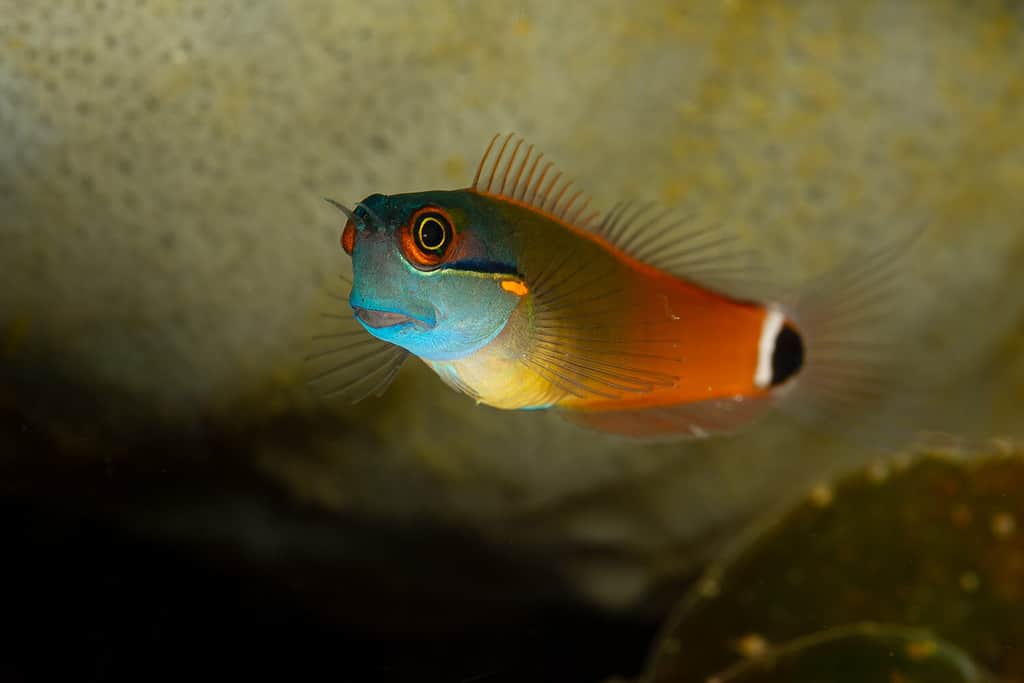
These spots are most prominent on the caudal fin, giving rise to its name of ‘Tailspot’ Blenny.
©Subphoto.com/Shutterstock.com
A Tailspot Blenny (Ecsenius stigmatura) is a small, colorful fish that is native to the Indian and Pacific Oceans. It usually grows up to around 4 inches in length, making it an ideal choice for smaller aquariums. Its body has a yellow base color with brown spots scattered across its fins and tail. These spots are most prominent on the caudal fin, giving rise to its name of ‘Tailspot’ Blenny.
It prefers warm temperatures between 72-78 degrees Fahrenheit and requires plenty of rockwork where it can hide away when feeling threatened or stressed. Additionally, their diet should consist mainly of herbivorous food like algae-based flakes and frozen foods such as brine shrimp or mysis shrimp.
Lawnmower Blenny
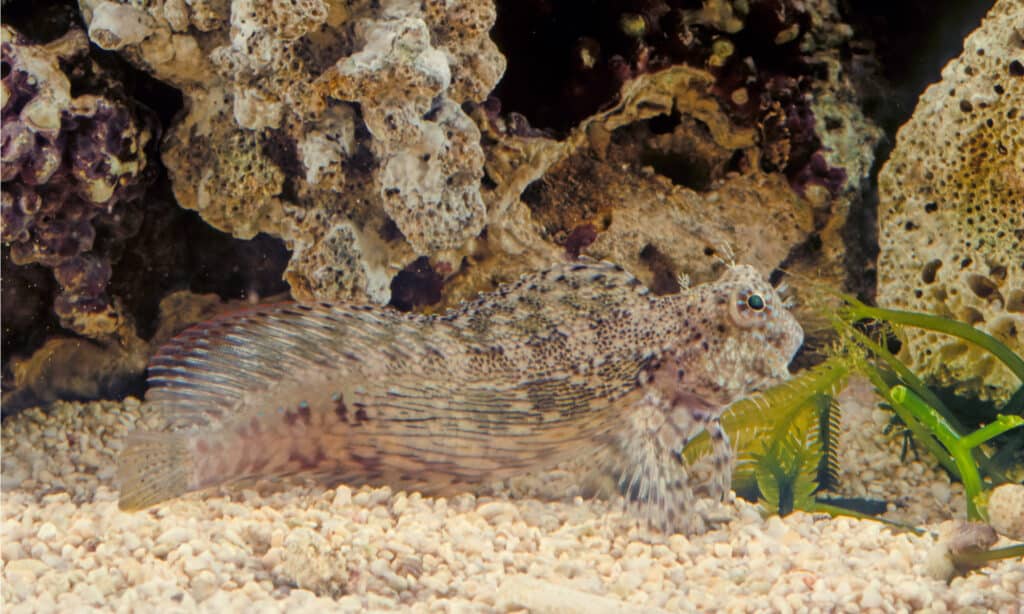
The Lawnmower Blenny spends most of his time grazing on algae growing on rocks or coral reefs.
©Roberto Dani/Shutterstock.com
The Lawnmower Blenny, scientifically known as Salarias fasciatus, is an intriguing fish species found in the warm subtropical waters of the Indian and Central Pacific Oceans. This small Blenny has a long body with a distinctive black stripe running from its head to its tail.
It’s usually around 2.5-4.75 inches in length and features a slightly protruding lower jaw which gives it a unique appearance. The Lawnmower Blenny spends most of his time grazing on algae growing on rocks or coral reefs, earning them a unique name for their “lawn mowing” behavior.
They are also sometimes referred to as the Jeweled Rockskipper due to their iridescent coloration when viewed up close. In addition to eating algae, they will also feed on small crustaceans and planktonic organisms that inhabit reef systems. The Lawnmower Blenny is generally peaceful towards other tank mates but may become territorial if they feel threatened or compete for food sources within the aquarium environment.
Midas Blenny
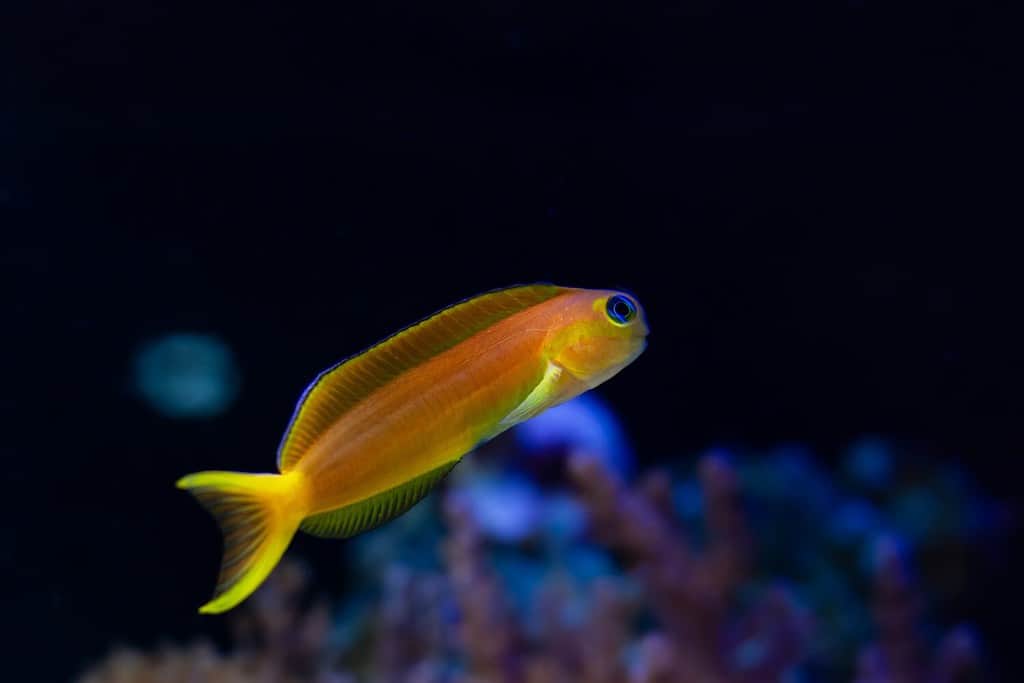
Due to their incredible jumping capabilities, it is suggested that their tank should have a secure lid attached in order to prevent any escapes.
©Aleron Val/Shutterstock.com
The Midas Blenny, known scientifically as Ecsenius midas, is a species of blenny fish that features an elongated body that transitions from light orange to golden yellow with sapphire blue highlights around the eyes.
They are hardy and can generally be housed peacefully in reef tanks alongside other peaceful fish but may become territorial with other blennies, dartfish, or gobies if they are kept in smaller tanks. Due to their incredible jumping capabilities, it is suggested that their tank should have a secure lid attached in order to prevent any escapes.
When it comes to diet, they should be given a variety of m foods, like vitamin-enriched brine shrimp and mysis shrimp, along with marine algae and spirulina 2-3 times daily for optimal health.
Scooter Blenny
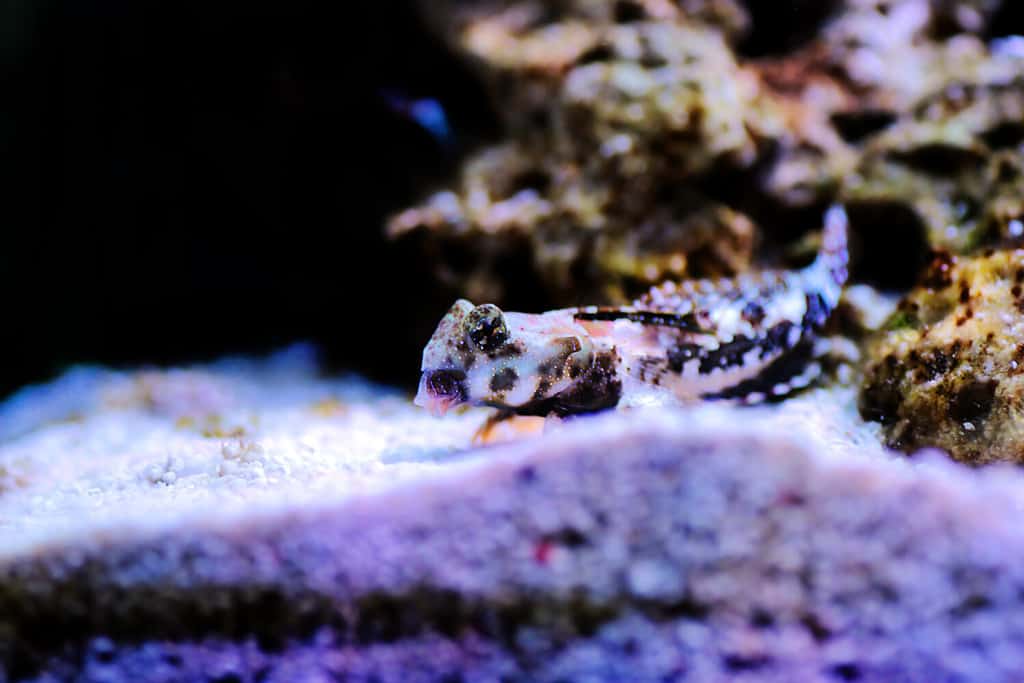
The scooter blenny may also feed on coral polyps if given the opportunity, so it’s important to keep these types of fish fed properly when kept in captivity.
©Vojce/Shutterstock.com
A Scooter Blenny, scientifically known as Synchiropus ocellatus, is a species of small fish found in the Indo-Pacific region.
They typically grow to be around 4-5 inches long and have an elongated body shape with a laterally compressed tail fin. The most distinguishing feature of this type of Blenny is its eye-catching color pattern, which consists of bright blue spots across its body accompanied by yellow-green stripes along the fins.
This beautiful fish usually inhabits shallow coastal reefs. They are often seen swimming around with their head held high in search of food such as plankton or algae. The scooter blenny may also feed on coral polyps if given the opportunity, so it’s important to keep these types of fish fed properly when kept in captivity.
Flametail Blenny

The Flametail Blenny, scientifically known as Enchelyurus flavipes, is a marine fish species that inhabits the western Atlantic Ocean.
©Vojce/Shutterstock.com
A Flametail Blenny, or Enchelyurus flavipes, is a type of marine fish found in the western Atlantic Ocean. It has an elongated body with a yellowish-orange coloration along its back and sides. Its tail fin is orange and has long red stripes running down it, giving it its distinctive “flametail” name.
The Flametail Blenny typically grows up to 4 inches (10 cm) in length and feeds mainly on zooplankton and small invertebrates such as copepods and amphipods. They are usually found hiding among rocks or coral during the day.
They become active at night when they come out to feed. The Flametail Blenny makes an interesting addition to any home aquarium due to its unique appearance and active behavior.
Bicolor Blenny
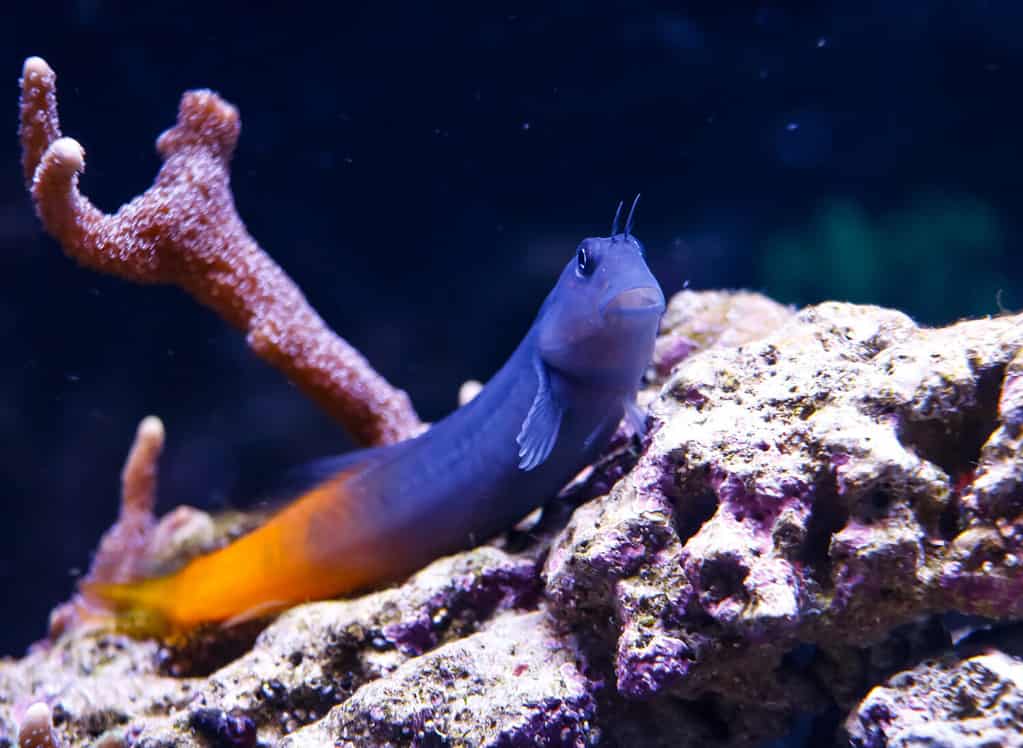
It is so named because of its two-colored body pattern, usually consisting of a light pale-colored front half and a bright or dark-colored back half.
©Tropical.aqua.art/Shutterstock.com
The Bicolor Blenny, Ecsenius bicolor, is a species of Blenny found in the Indo-Pacific region.
It is so named because of its two-colored body pattern, usually consisting of a light pale-colored front half and a bright or dark-colored back half. Silver and orange are the most common bicoloration. This fish can reach up to 5 inches in length. It has an elongated dorsal fin with a curved front edge.
The Bicolor Blenny lives on rocky reefs, where it feeds mainly on algae and small invertebrates such as worms and crustaceans. Its diet also includes zooplankton and occasionally other fish eggs or larvae, which it catches by using its long snout for hunting for food among crevices in rocks.
Ruby Red Dragonet
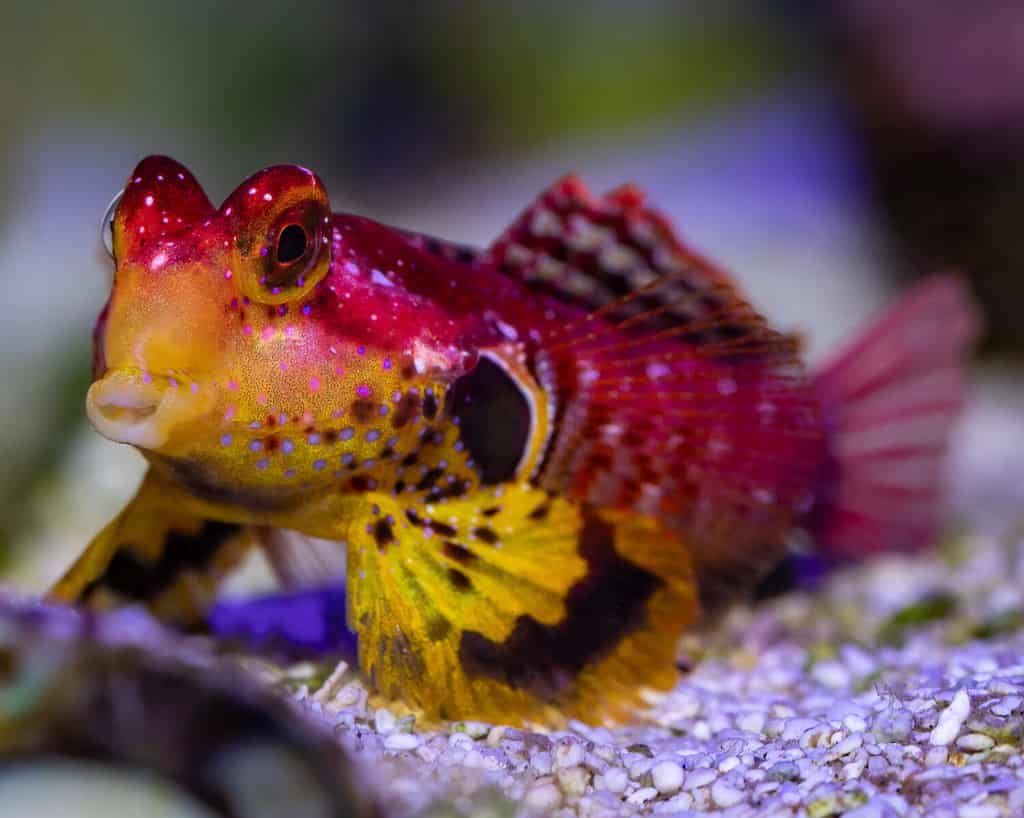
Though these fish can be territorial towards one another, they tend to get along with other species when kept in a community tank.
©Joshua Silsbury/Shutterstock.com
The Ruby Red Dragonet, Synchiropus sp., is a type of blenny fish that belongs to the Callionymidae family. Native to the Pacific Ocean, they are highly sought after due to their striking and vibrant coloration.
This small fish has an elongated body with red scales covering most of it and bright yellow fins. They have two large eyes on either side of their head, which helps them detect prey in low-light environments.
Their diet mainly consists of planktonic crustaceans, worms, and other small invertebrates found near coral reefs or rocky bottoms. Though these fish can be territorial towards one another, they tend to get along with other species when kept in a community tank as long as there is plenty of hiding places for them to retreat into if needed.
They are also known for being shy, so providing adequate cover is essential for happy and healthy specimens.
Orange Spotted Blenny
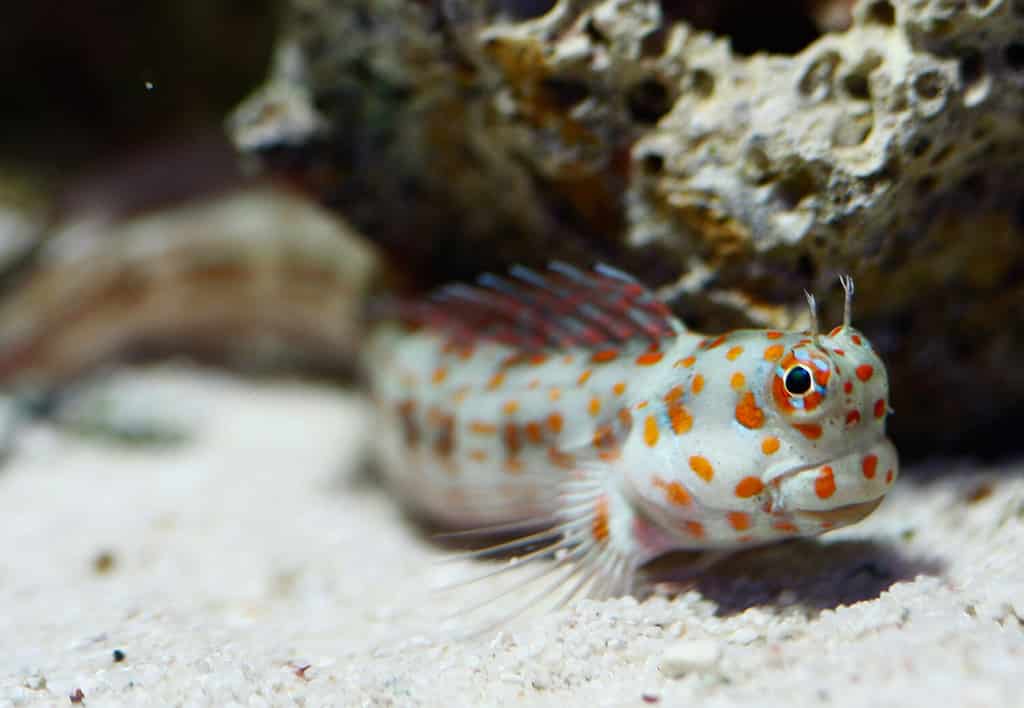
Orange spotted blenny are relatively peaceful creatures but should not be housed with other aggressive fish due to their timid nature.
©Pavaphon Supanantananont/Shutterstock.com
The orange spotted Blenny, also known as Blenniella chrysospilos, is a small saltwater fish that originates from the Indo-Pacific region. It ranges from East Africa and Hawaii to Japan and Micronesia. This species of Blenny can be identified by its bright orange spots on either side of its body. It also has numerous white stripes running along the length of it.
These fish usually measure up to 4 inches in length and have an elongated body shape with a pointed snout. They are relatively peaceful creatures but should not be housed with other aggressive fish due to their timid nature.
In addition, they require plenty of live rock for hiding spaces when frightened or scared. As omnivorous feeders, these fish will eat both meaty foods such as frozen brine shrimp and flake food varieties. They also enjoy algae wafers for vegetative nutrition.
Canary Blenny
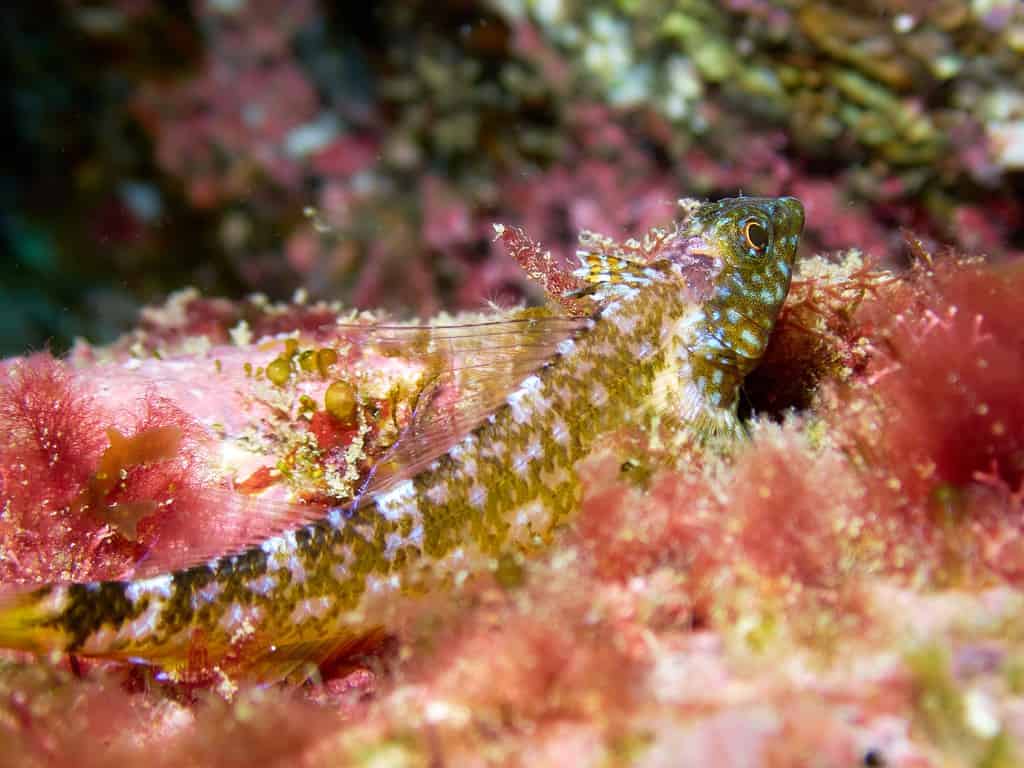
©Wirestock Creators/Shutterstock.com
A canary blenny, scientifically known as Meiacanthus ovalaunensis, is a type of blenny fish that originates from the western Pacific Ocean.
This species is commonly found in ocean reefs and lagoons at depths between 16-30 ft. It has an elongated body that is bright yellow. Some varieties have a black stripe. The male canary Blenny typically grows to around 4 inches long, while females are slightly smaller.
They feed on small invertebrates such as worms, crustaceans, and zooplankton, which they hunt for among coral heads and rocks.
Although not aggressive by nature, males may become territorial when breeding season arises due to their harem spawning behavior, where one male will mate with multiple females simultaneously.
Striped Blenny
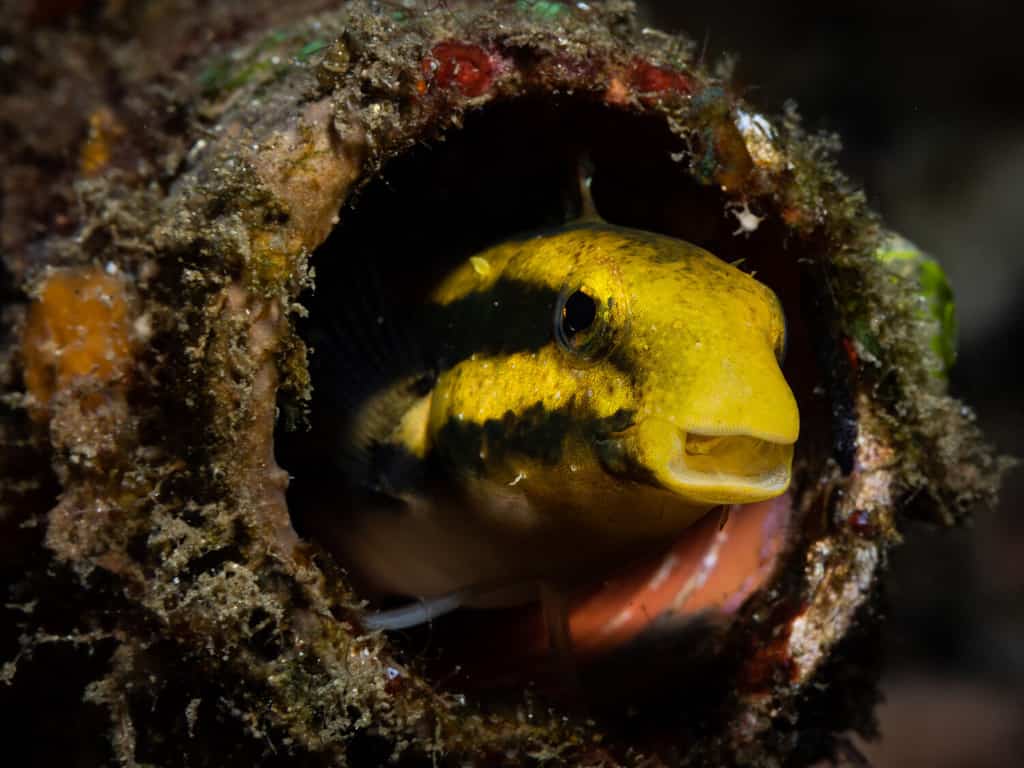
Striped blennies feed on smaller invertebrates such as worms, insect larvae, and copepods, among others.
©Henryp982/Shutterstock.com
The striped Blenny (meiacanthus grammistes) is a small fish that typically grows to around 4 inches in length. It has an elongated body shape and can be easily identified by its unique coloration, which consists of alternating yellow and dark brown stripes running down its back.
The tail fin of the striped Blenny is usually more colorful than the rest of its body. It has bright shades of blue and red often present, or the fin can be pure black.
This species also has large eyes and two separate dorsal fins. One fin is near the head and another closer to the tail section. They are natively found in areas like Japan, Indonesia, Australia, New Caledonia, Fiji Islands, and other parts of the Pacific Ocean.
They inhabit coral reefs at depths up to 60 feet or more. Striped blennies feed on smaller invertebrates such as worms, insect larvae, and copepods, among others.
Two Spot Blenny
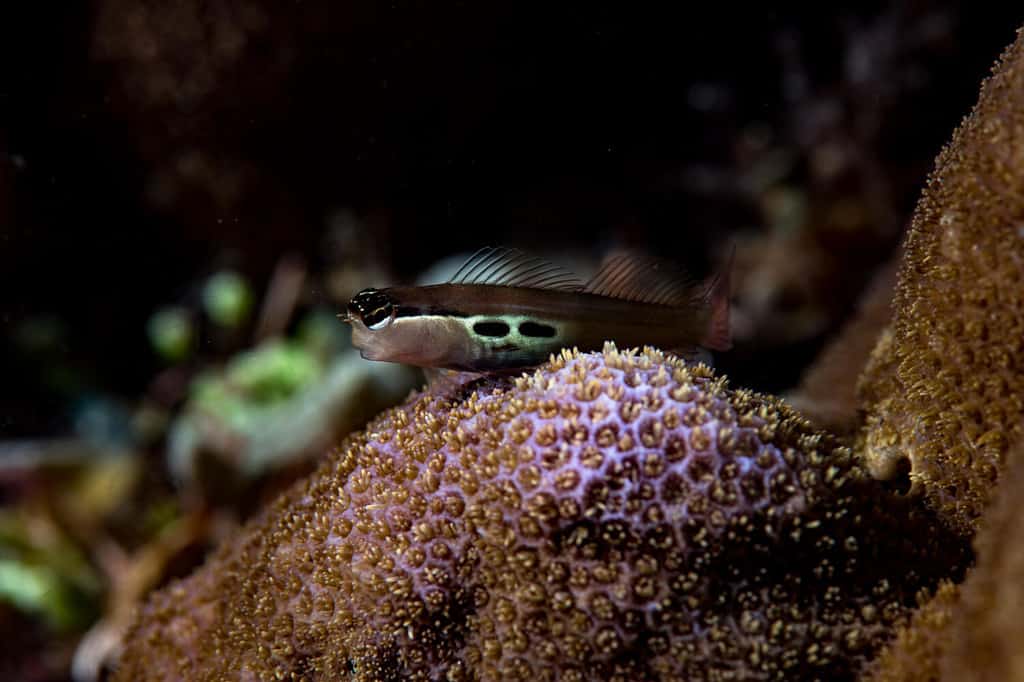
The two-spot blenny prefers coral reefs or rocky areas for shelter as well as a sandy substrate for burrowing during nighttime.
©Francesco_Ricciardi/Shutterstock.com
The two-spot Blenny, Ecsenius bimaculatus, is a species of small fish native to the Indo-Pacific region. They typically grow up to 3 inches in length and have a stocky body shape with large eyes. As their name suggests, they are characterized by two black spots located behind their operculum (gill covers).
They have another one between the first dorsal fin spine and the second. In addition to these spots, they also feature blotches and stripes on different parts of their bodies. They vary depending on where it is found geographically.
They prefer coral reefs or rocky areas for shelter as well as a sandy substrate for burrowing during nighttime. Their diet consists mainly of algae. Other food items, such as small crustaceans, can be included in their menu from time to time too.
Smith’s Blenny
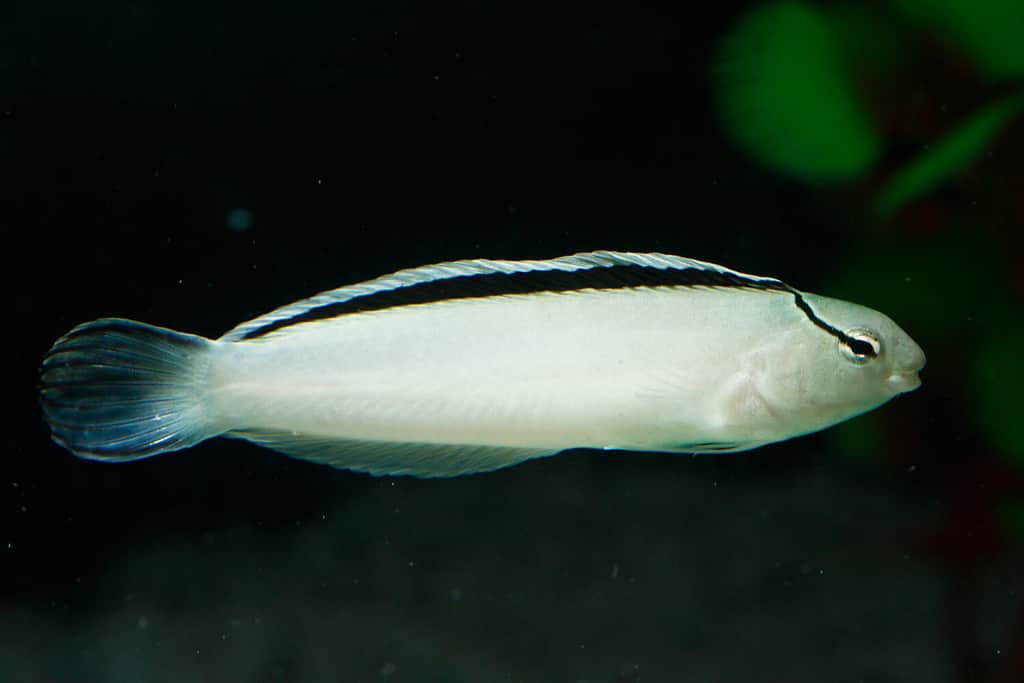
This species of fish makes an excellent addition to any saltwater aquarium, thanks to its lively nature and interesting coloration!
©Pavaphon Supanantananont/Shutterstock.com
Smith’s blenny, also known as Meiacanthus smithi, is a species of marine fish belonging to the family Blenniidae. The adult Smith’s blenny grows up to 3 inches in length and has a distinctively elongated body. It is characterized by its bright silver head with two black stripes running from the eyes down the body, ending near the caudal fin.
They have blunt heads with big eyes and small mouths located near their snouts. Their diet consists mostly of zooplankton and algae. They feed on while grazing over rocks or other surfaces in shallow waters. This species of fish makes an excellent addition to any saltwater aquarium, thanks to its lively nature and interesting coloration!
Summary of the 12 Unique Types of Blenny Fish
Here are the 12 Unique Types of Blenny Fish:
| Rank | Blenny Fish |
|---|---|
| 1 | Tailspot Blenny |
| 2 | Lawnmower Blenny |
| 3 | Midas Blenny |
| 4 | Scooter Blenny |
| 5 | Flametail Blenny |
| 6 | Bicolor Blenny |
| 7 | Ruby Red Dragonet |
| 8 | Orange Spotted Blenny |
| 9 | Canary Blenny |
| 10 | Striped Blenny |
| 11 | Two Spot Blenny |
| 12 | Smith’s Blenny |
The photo featured at the top of this post is © Roberto Dani/Shutterstock.com
Thank you for reading! Have some feedback for us? Contact the AZ Animals editorial team.






